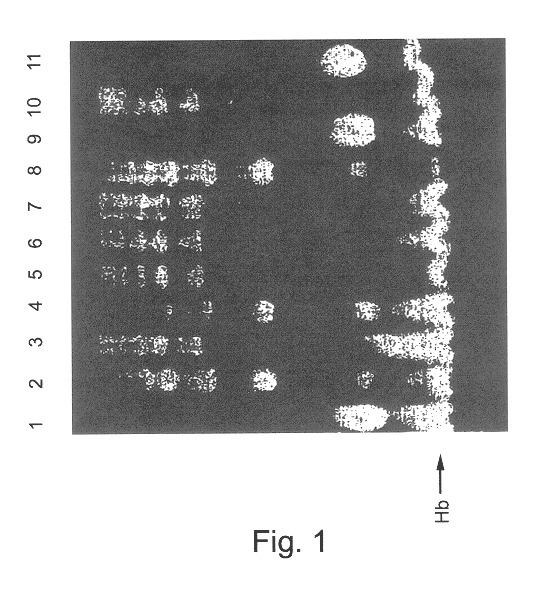This is particularly problematic in view of the increased incidence and extent of
coronary artery disease in this
population, often necessitating simultaneous treatment of multiple lesions in the same patient.
However, it is well recognized that not all patients with DM will develop DR and that not all patients with DR progress to
sight-threatening proliferative DR.
Currently there is no way to predict which patients are most likely to be affected by this problem.
A genetic basis for collateral formation in the setting of coronary diseases has been described but remains controversial because no specific
gene associated with collateral formation has been identified.
Restenosis occurs in 16% to 59% of patients who undergo
percutaneous transluminal coronary
angioplasty (PTCA), thereby severely limiting its long-term benefits (Faxon D P. Predicting
restenosis--bigger is better but not best.
This patent does not teach the use of haptoglobin phenotype as a
risk factor in vascular complications in DM.
However, teachings of this patent do not include the idea that haptoglobin 1-1 phenotype is a positive predictor for reduced tendency towards vascular complications in DM.
At present, it is, however, not known and cannot be predicted whether Hp1-1 phenotype mitigates the vascular complications in diabetic patients.
Prolonged (chronic)
oxidative stress leads to LDL oxidation, which may result in chronic vascular complications.
However, its use is not widespread due to the need to begin therapy at least 4 weeks prior to the PTCA.
The use of LCR for
mutant screening is limited to the examination of specific
nucleic acid positions.
However, available thermostable
DNA ligases are not effective on this
RNA substrate, so the
ligation must be performed by T4
DNA ligase at low temperatures (37 degrees C.).
Therefore the reaction temperatures cannot be raised to prevent non-specific hybridization of the probes.
In practice, routine
polymerase chain reactions rarely achieve the theoretical maximum yield, and PCRs are usually run for more than 20 cycles to compensate for the
lower yield.
Reaction conditions must be carefully optimized for each different primer pair and target sequence, and the process can take days, even for an experienced investigator.
The laboriousness of this process, including numerous technical considerations and other factors, presents a significant drawback to using PCR in the clinical setting.
Indeed, PCR has yet to penetrate the clinical market in a significant way.
One method of the detection of
allele-specific variants by PCR is based upon the fact that it is difficult for
Taq polymerase to synthesize
a DNA strand when there is a mismatch between the template strand and the 3' end of the primer.
This method has a substantial limitation in that the base composition of the mismatch influences the ability to prevent extension across the mismatch, and certain mismatches do not prevent extension or have only a
minimal effect (Kwok et al., Nucl.
Any mismatch effectively blocks the action of the thermostable ligase, but LCR still has the drawback of target-independent background
ligation products initiating the amplification.
Moreover, the combination of PCR with subsequent LCR to identify the nucleotides at subject positions is also a clearly cumbersome proposition for the clinical laboratory.
Traditional methods of direct detection including Northern and Southern band RNase protection assays usually require the use of radioactivity and are not amenable to
automation.
However, specialized equipment and highly trained personnel are required, and the method is too labor-intense and expensive to be practical and effective in the clinical setting.
However, this method requires the use of
osmium tetroxide and
piperidine, two highly noxious chemicals which are not suited for use in a clinical laboratory.
RFLP analysis suffers from low sensitivity and requires a large amount of sample.
When RFLP analysis is used for the detection of point mutations, it is, by its nature, limited to the detection of only those single base changes which fall within a restriction sequence of a known restriction
endonuclease.
Moreover, the majority of the available enzymes have 4 to 6 base-pair recognition sequences, and cleave too frequently for many large-scale
DNA manipulations (Eckstein and Lilley (eds.
Furthermore, the method requires specialized equipment to prepare the gels and maintain the needed high temperatures during
electrophoresis.
In addition, long running times are required for DGGE.
This technique is extremely sensitive to variations in gel composition and temperature.
A serious limitation of this method is the relative difficulty encountered in comparing data generated in different laboratories, under apparently similar conditions.
While ddF is an improvement over SSCP in terms of increased sensitivity, ddF requires the use of expensive dideoxynucleotides and this technique is still limited to the analysis of fragments of the size suitable for SSCP (i.e., fragments of 200-300 bases for optimal detection of mutations).
In addition to the above limitations, all of these methods are limited as to the size of the
nucleic acid fragment that can be analyzed.
For the
direct sequencing approach, sequences of greater than 600 base pairs require
cloning, with the consequent delays and expense of either deletion sub-
cloning or primer walking, in order to cover the entire fragment.
SSCP and DGGE have even more severe size limitations.
Because of reduced sensitivity to sequence changes, these methods are not considered suitable for larger fragments.
The ddF technique, as a combination of
direct sequencing and SSCP, is also limited by the relatively small size of the DNA that can be screened.
 Login to View More
Login to View More 


